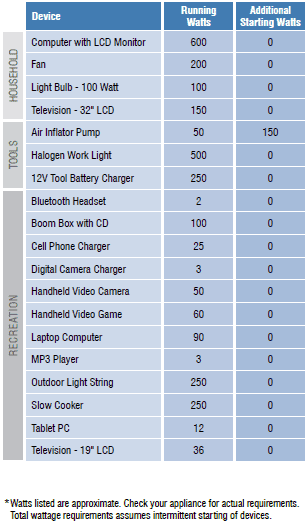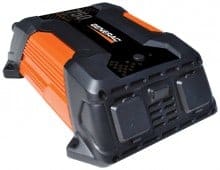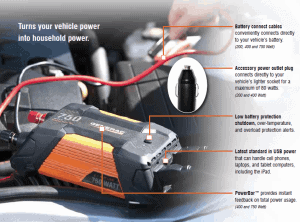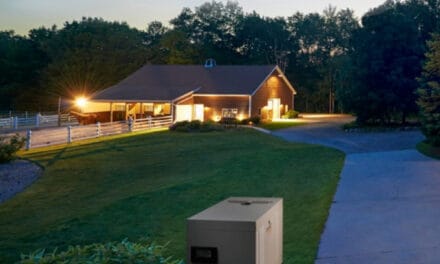We drive around in vehicles that produce quite a bit of power. Most of the power is mechanical and is used to propel the vehicle in whatever direction we want to go. This is true on cars, RVs, boats, trucks, and more.
Some of the power produced in a vehicle is electrical, but even though a 12-volt battery can start a car, it won’t turn on your TV or let you plug in your laptop without a special adapter.
The current from a battery is 12-volts DC. The current in your home is 110 to 125 volts AC.
The two power types and voltages are not compatible. Adapters can lower voltage and convert AC to DC. We plug them into our wall sockets to charge cell phones and laptop batteries. An inverter is just the opposite—it plugs into a vehicle battery and converts DC to AC while increasing the voltage to 115 volts.
Battery Power
A fully charged 12-volt automobile battery has an output of about 12.7 volts. The amount of current it can produce in amperes varies by the battery and is largely dependent on the power requirements of the vehicle’s starter. The power from a vehicle battery is in constant use. It provides energy to make the spark that fires the spark plugs and powers lights, radios, and any other accessories in use. Without a means of recharging, the battery is gradually depleted until it can no longer produce enough electrical current to start the car or turn on the lights.
This is an important factor to remember: batteries have a limited amount of power available. Use too much without recharging and you will deplete the battery.
Generac Inverters
The inverters by Generac Power Systems include models that produce 100, 200, 400, and 750 watts of continuous power. Their peak, or surge rating, is the amount of power they can produce momentarily to help start a motor such as an air pump or electric fan. Surge watts are about double the continuous watts, but the inverter will only produce that power for a moment.
The power available from a 12-volt outlet such as a cigarette lighter or convenience outlet is limited. The 100-watt units can plug into it, larger units connect directly to the battery with a supplied battery cable. The battery connections make it possible to connect the inverter directly to a non-vehicle battery or group of batteries connected in parallel to use as a temporary power source.
Two important features (not available on 100-watt inverters) are a low battery alarm and low battery shutdown. They help prevent discharging the battery until it is dead—helpful for keeping your vehicle ready to go.
Available Power

How do you determine what size power inverter you need? Sizing power inverters is relatively easy. Check out this Sample
Add up the power requirements (in watts) of the items you’d like to power with an inverter. Then choose the model that exceeds your maximum requirements. If you need 600 watts, then select the 750- watt inverter. Most electrical or electronic devices have a tag that will give the power required. Some supply a volt and amp rating—just multiply volts by amps to calculate watts.
Approximate power requirements:
- Laptop – 90 watts
- Desktop and LCD Monitor 600 watts
- 75-watt light 100 watts
- 32-inch LCD television 150 watts
- 12-volt tool charger 250 watts
- cell phone charger – 25 watts
- slow cooker – 250 watts
- Tablet computer – 30 watts
Battery Use
Remember that the battery has a limited supply of power. The bigger the battery (rated in amps,) the longer it can produce power. Several batteries connected in parallel can supply power much longer than a single battery. Eventually, the battery or batteries will require charging. You can do this by driving your vehicle or by connecting the batteries to a battery charger.
Inverters are useful for powering small appliances that you normally could not use without a house outlet to plug into or without purchasing a special adapter. You can take power on the road or use it at home in an emergency. If you need more power, consider a standby generator or portable generator.

















